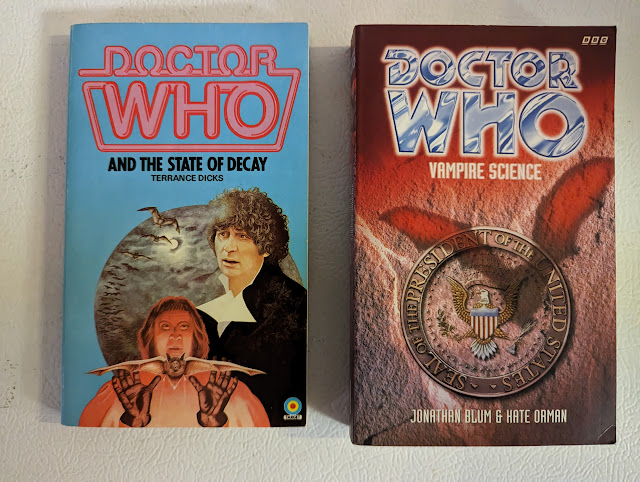The Doctor: Do you know, it just occurs to me there are vampire legends on almost every inhabited planet.
Romana: Really?
The Doctor: Yes.
- The Fourth Doctor and Romana II, "State of Decay"
Honestly, it would not be an April A to Z V-Day if I didn't do Vampires, and Doctor Who is no different. You might think a sci-fi family show would not have much to do with Vampires, but it does, and they are part of the show's history.
State of Decay
The first use of vampires was the later Tom Baker story from the Fourth Doctor era, "State of Decay." The Doctor and Romana had fallen into a CVE, or a hole in the universe into another universe (E-Space).
Here we get the background on vampires in the Doctor Who universe. Long ago in even the ancient times of Gallifrey the Time Lords, led by Rassilon, fought the great Vampires. These creatures were huge (maybe related to the Dæmons as some of the books say) and they "swarmed" across the cosmos draining entire worlds. Rassilon invented the "bow ships" to impale them on a massive spike of steel, the only way to truly kill them. The time Lord destroyed them all except for their leader, the Great Vampire. The Doctor, Romana, and Adric find them in E-Space. Here three human explorers from Earth got trapped in E-Space and began to feed the Great Vampire. It has taken thousands of years to restore him, but the Doctor manages to destroy him once and for all.
One of the vampire humans in this story, Camilla, was obviously named after Sheridan Le Fanu's "Carmilla." Likewise, Camilla shows more than a casual interest in Romana II.
There is an implication here that Time Lords and Vampires share a long history, maybe even before their war. The various novels in the "New Adventures" series expanded on this.
I watched "State of Decay" for my October Horror Movie Marathon a while back. I don't have the DVD, but as part of the Tom Baker Season 18 Blu-Ray.
The whole episode was a huge homage to Hammer Horror, much like The Brain of Morbius was.
The Curse of Fenric
This story from the 7th Doctor era is also a favorite of mine. In the far future when the Earth is a toxic dump, it is the home of the Haemovores or mutated humans that needed the blood of others to survive. They could pass on their mutation to others, turning them into vampire-like creatures. They were not undead, like the human-turned-vampires of the Great Vampires, but shared many of the same features. They were, for example, very suspectable to psychic attacks and a strong-willed human, even ones with no psychic ability, could keep them at bay.
I am uncertain if these creatures are related to the Great Vampires or not; it seems that they are not.
Smith and Jones
The first episode of David Tennant's 2nd season as the Doctor introduces us to Martha Jones and a Plasmavore, a type of vampire-like alien that feeds on blood. This creature is another variation on the vampire theme but has no relationship (as far as I know) to the Great Vampires or even the Haemovores. Though they do seem more closely related to the Haemovores in their need for the salt content in their victims' blood.
Vampires of Venice
A run with the 11th Doctor exposes Amy and Rory to the Saturnyn, another type of vampire (sexy fish vampires, according to the Doctor). They could live off of the water content in people's blood. They could make humans into their own species by replacing all their blood.
The Saturnyn lost their homeworld due to the cracks in the Universe (caused by the Doctor's exploding TARDIS in the future) and "the Silence" a major plot point for this season.
We will likely see more vampires in the future, hopefully going back to the original Great Vampires.
All images (expect for personal ones) are used with permission from the BBC and are copyrighted 2023 by the BBC.





1 comment:
It is weird how many cultures can have similar myths like vampires, dragons, or Bigfoot/Sasquatch/yeti. All the different ways they've done it in this series show how vampires have managed to survive in our cultures because the basic properties can be adapted and re-adapted in different ways--like sparking in daylight. Ugh.
Post a Comment